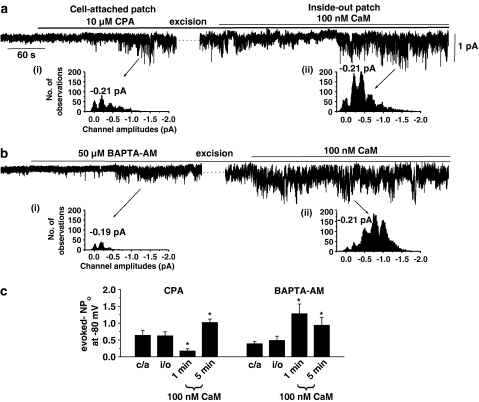Figure 3.
Effect on CaM on SOCs evoked by CPA and BAPTA-AM. (a) Bath application of 10 μM CPA induced channel currents in a cell-attached patch held at −80 mV, which were maintained after excision into the inside-out configuration at −80 mV. Coapplication of 100 nM CaM to the inside-out patch then produced an initial marked suppression of channel activity followed by a pronounced increase in activity (e.g. 5 min). (b) Following activation of SOCs by 50 μM BAPTA-AM in cell-attached mode and excision of the patch, coapplication of 100 nM CaM induced only a marked increase in channel activity in another inside-out patch. The insets (i) and (ii) in (a) and (b) show amplitude histograms and illustrate that the CaM-induced increases in channel activity were due to an increase in the activity of channel currents with a similar unitary amplitude. The peaks greater than the unitary amplitudes represent openings of more than one SOC in the patch. (c) Mean data showing the inhibitory and excitatory effects of CaM measured at 1 and 5 min on SOCs evoked by CPA and BAPTA-AM (c/a=cell-attached patch, i/o=inside-out patch, *P<0.05). Note that CaM only produced an excitatory effect on BAPTA-AM-induced SOCs.

